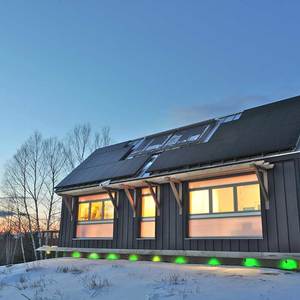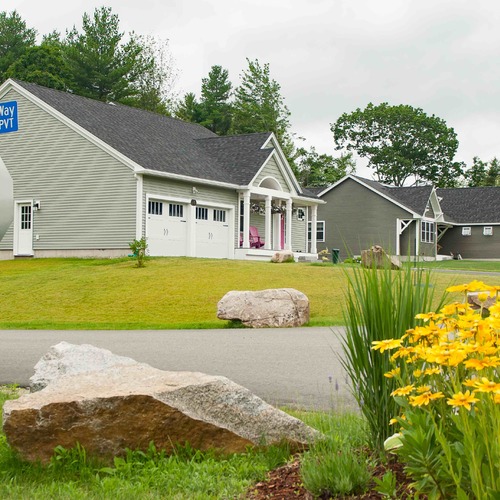
High performance homes save energy, conserve water, are more durable, cost less to maintain, are healthier for the occupants and are less stressful on the environment. Simply put, they are better homes! However, how do you explain “better” to your customers to help them make the decision to buy your green-built homes?
Here are some tips to help you market and sell more homes.
1. Educate your customers on the value provided by your high-performance homes. Take the time to explain the features and benefits of your homes. Use simple and easy-to-understand language when you speak with your customers about the features.
For example, describe why you use a higher-performance insulation, such as blown-in cellulose insulation or sprayed foam insulation, versus fiberglass insulation. Prospects will take a more favorable position to embrace the value offered by this feature when they understand the connection between how the type of insulation used makes the home airtight, and saves them money on their energy bills.
Inform the customers on energy and water-conserving features used in your homes, such as ENERGY STAR appliances, low-flow faucets, water-conserving toilets, tankless water heaters. Express how these features help reduce operating costs.
Communicate to your customers the green building program you use to build and certify your homes. Show how this provides homeowners peace of mind through a third-party home verification process.
Focus your customers’ attention on the value of the features. A consumer survey conducted by DoubleClick Performics states that “Consumers, when choosing between two similar products, prefer environmentally friendly products; 83 percent indicated they are extremely or very likely to choose the environmentally friendly option.”
If you have not selected a green building program, contact your local homebuilders association to learn about the options available, or check out NAHB’s Green Building Program and Environments for Living.
When you have a model home, it is much easier to point out these features so that customers can see, touch and feel. If you do not have a showroom or model home, you can employ other creative strategies for illustrating your homes’ features, which leads us to the next tip.
2. Market your difference in the types of homes you build, the green building programs you use, and your company’s commitment to serving the community while protecting the environment.
Make a list of all the green features of your homes and find a way to communicate this effectively and with pizzazz in your company brochure and website. If you are not a writer, hire professional help! (Go to www.elance.com to find all kinds of professional assistance).
If you do not have a website, have one made by an expert! Your marketing pieces such as your brochure, business cards, and your website should be consistent and inviting. Your marketing materials reflect your professionalism for the work you do and the value you put on your customers. Most buyers today surf the internet first and narrow down their search to a few builders prior to contacting them.
The internet gives you a tremendous opportunity for you to “pre-sell” your homes. Make your website inviting and informative about your homes’ features and what’s in it for them. Your website needs to serve as your first emotional connection between you and your potential customers. Create your website to be easy to navigate and have consumer-friendly content.
3. Train your staff to know the top three features of your homes by heart and be able to speak about them spontaneously. Everyone in your team is a sales person. Practice through role-play and various scenarios. The advantage of having all your staff trained on the subject will pay you huge dividends.
One of the greatest advantages of a trained team is that they will all speak the same language. This will give your customers a seamless experience throughout the sales process, construction and after move-in.
4. Talk the walk by pointing out the activities that your company does to build a cleaner environment for future generations. Magnify your community involvement, support of eco-friendly efforts, your personal commitment to green education to stay abreast of the latest green building practices, your recycling and reusability techniques employed by your company. Customers cannot appreciate your efforts if they are not exposed!
DoubleClick Performics survey concludes that: “consumers are as interested in the company as the products they are researching.” Every single high performance home you build contributes to a cleaner environment and enhances the lives of those who are enjoying them today, and those that will experience their benefits in the future.
Use value-based marketing and you will reap its rewards!
Weekly Newsletter
Get building science and energy efficiency advice, plus special offers, in your inbox.















11 Comments
Behind the wallls
Since many of the features that make a home green are hidden behind the walls. Spray foam insulation, radiant barriers and special techniques for insulating foundations are all hidden in the final product. I think an important part of marketing is to show the process. Something I've done in http://www.greenshowcaseli.com.
Selling Value
3rd Party Verification is such an important element in declaring that your product is green. See only green verified homes http://www.greenverifiedhomes.com. This site will only allow listings where the owner has listed the Verifier and the Certification level. Good idea to instill faith and trust in a new product that claims and promotes performance. The verifier and the certification both build trust.
Behind the walls
John, excellent video! This is very helpful for homeowners to see the value hidden behind the walls! Thank you for sharing the link and your comments.
Selling Value
Gary, thank you for sharing about green verified homes. This is a great resource, like you said, "to instill faith and trust" with the customers we work. Greatly appreciate it!
Truth Windows ..demos and mock-ups
Hi Dina...Nice blog
I wanted to add to John A.'s comment about hidden value.
Some Builders.. Like Vernon Mckown (Ideal Homes)are demonstrating the "hidden value" with mock-ups and hands-on demonstrations in the model home.
Things that buyers can touch and interact with are good.
A truth window that shows the interior of the wall or ceiling is helpful also.
Truth Windows...demos and mock-ups
Hello John! I agree with you on having mock-ups and hands-on demos in model homes! This helps buyers understand the value of the green practices we employ to build these eco-friendly homes.
I love the video that we have on Green Building Advisor's home page from Pulte Homes, which shows how they facilitate homebuyers to "touch and feel" the quality products being installed in their homes: https://www.greenbuildingadvisor.com/blogs/dept/green-building-news/how-sell-green-homes.
Along the same line, the Virtual Home Tour by Environments for Living is phenomenal to help educate consumers on the value green building practices brings to them! http://www.environmentsforliving.com/
Thank you for your comments!
Shades of Green
The one thing I find with many builders is that they simply want to do the barest minimum to be able to say their product is green. The consumer is very familiar with Energy Star, but few, if any, know the difference between a HERS rating of 85 (minimum for rating qualification) and a rating of 0 (home produces all the energy it consumes). The same can be said of most green building ratings (bronze, silver, gold, etc.).
The consumer is going to have to be educated before they encounter builders. (Most) builders, who possess little education themselves, are seldom qualified to be on the front lines of educating consumers about quality, durability, efficiency, health and conservation. Claims that a home is more than it actually is will hurt green building in the long run.
I often tell builders that "You must know your customer, empower that customer through education, act with transparency to back your claims, reassure buyers that your home performs as promised through proof points, and be able explain the economic benefits of your product." I always find it amusing that I encounter the most resistance on the "act with transparency" part because most do not want to portray themselves as doing the barest minimum to get a rating.
The bottomline is that the consumer needs to know what is available to them - not just what a particular builder is marketing to them.
Features or Benefits?
Dina - Overall a good primer on how to market green, but take issue with one sentence: Make a list of all the green features of your homes. We need to be talking about benefits not features. The big issue with green building is that it is not about the products, it is the process and the results of that process are benefits to the homeowner - improved indoor environment that can help reduce allergies, mold, and mildew; better humidity control making their home more comfortable; less dust - which means less time cleaning; reduced maintenance; oh, and by the way, they will save money on their energy bills. We need a concerted, long term, broad based educational effort to make anything but a green home clearly inferior so everyone will want theirs green. I like the car analogy - most any car will get you there: Mercedes, Cadillac, Toyota, Rolls, or even a Yugo (at least some of the time), but do you want to live in a house that performs like a Yugo? Most standard homes perform at that level. If you can point that out to a homeowner, they should understand the value in a high performance home and be ready to pay for it.
Shades of Green
Hello Grant. You're very right when you state "The bottomline is that the consumer needs to know what is available to them - not just what a particular builder is marketing to them." As builing professionals we now have to be educators to homebuyers by explaingin the benefits of the features... this answers their question "what's in it for me". Thank you for your comments!
Features or Benefits
Hello Carl. Totally agree with you on pointing out the benefits of the features. As professionals, we need to be sure we provide the buyers with choices so that they can make informed decisions based on their lifestyle needs. A builder should have a list of the basic features AND the benefits each of them offers to the homeowners. In the process of getting to know the customer through questions (which needs to be the first step when a customer makes the first contact with the builder) the builder needs to learn about the needs to the buyer, and the features included in the home can meet their home needs. Totally agree with you... the focus has to be on "what's in it for them", because in the end, it's not about the builder, but the customer! Thank you for the examples you provided in your comments.
Great Tips for Green Business
Hello Karen! Yes, as green professionals (in whatever industry we're in), we need to continually educate ourselves to offer greater value to our customers. The work that you are doing with green cleaning products and educating your customers about them is very commendable. Keep it up!
Log in or create an account to post a comment.
Sign up Log in